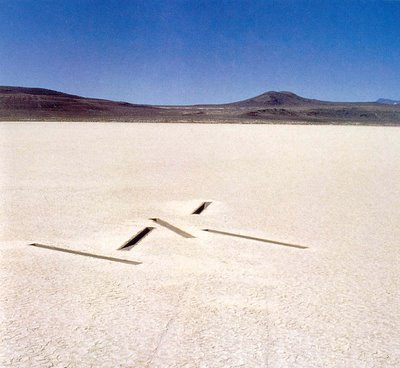Michael HEIZER
Dissipate (deteriorated)
# 8 of Nine Nevada Depressions
1968
Wood
1,400 x 1,500 x 30 cm
Black Rock Desert, Nevada
Black Rock Desert, Nevada
Heizer set pieces of wood into lhe flat bottom of a dried lake
The artist was aware
how quickly this work would be reclaimed into lhe landscape.
He explained, 'As the
physical deteriorates, the abstract proliferates,
exchanging points of view'
- Michael Heizer, Artforum, 1969
His main interest in making this piece was the gradual transformation and
deterioration of lhe piece with the passage of time as the natural environment erases
his intervention in the landscape,
Land and Environmental Art
Jeffrey Kastner
Brian Wallis
Phaidon

1 comentário:
MICHAEL HEIZER
Born: 1944
Died:
Gender: Male
Nationality: American
"A type of art that uses as its raw materials earth, rocks, soil, and so on." Definition of 'Land Art' from the Oxford Dictionary of 20th Century Art by Ian Chilvers.
Michael Heizer was born to a family of geologists and archeologists leading him to a fascination with mysterious sites marked by evidence of ancient technology such as the shifting of huge stones.
In awe of these primitive efforts, Heizer was inspired to make his own markings on the earth. With 'Double Negative' (1969-1970) he carved out an enormous trench 30 feet wide, 50 feet deep and a third of a mile long in a straight line across the Virgin River mesa in Nevada. Possibly his most fully realised creation was 'Complex One' (1972) in Hiko near Nevada. It is an enormous pile of earth sandwiched between two triangles made from reinforced concrete, with large concrete beams inflecting the structure. Measuring 140 feet long and 110 feet wide, the construction was massive. Robert Hughes in his American Visions describes 'Complex One' thus; "[It] recalls... the enigmatic structures left behind by America's various nuclear and space programmes, which by the 1970s were already beginning to seem an archeology of the Age of Paranoia."
Heizer's contributions to 'Land Art' were just a few of the many works by artists working during the Sixties who saw their earthwork schemes as a reaction to traditional gallery art and the material gain signified by institutions. Inspired as they were by primitive structures, the movement can be seen in line with hippie culture in the move away from developing technology to embrace the beauty of nature. The irony is that as the land artists including Robert Smithson, James Turrell, Mary Miss as well as Michael Heizer, enforced their grand creations upon the environment with such bravado that the natural beauty of their surroundings was often destroyed in favour of the artist's need to make a statement.
(articons.co.uk/heizer.htm)
Enviar um comentário